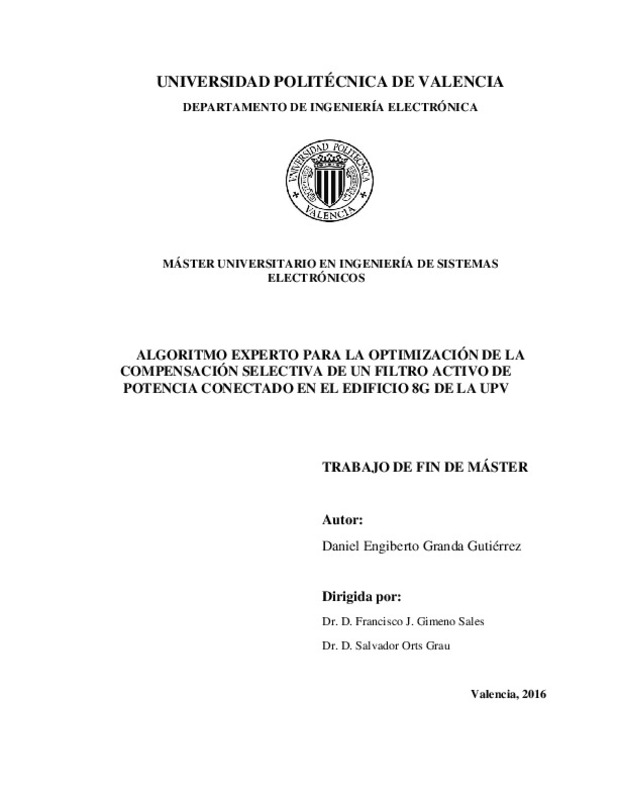JavaScript is disabled for your browser. Some features of this site may not work without it.
Buscar en RiuNet
Listar
Mi cuenta
Estadísticas
Ayuda RiuNet
Admin. UPV
Algoritmo experto para la optimización de la compensación selectiva de un filtro activo de potencia conectado en el edificio 8G de la UPV
Mostrar el registro sencillo del ítem
Ficheros en el ítem
| dc.contributor.advisor | Orts Grau, Salvador
|
es_ES |
| dc.contributor.advisor | Gimeno Sales, Francisco José
|
es_ES |
| dc.contributor.author | Granda Gutiérrez, Daniel Engiberto
|
es_ES |
| dc.date.accessioned | 2017-01-17T10:22:13Z | |
| dc.date.available | 2017-01-17T10:22:13Z | |
| dc.date.created | 2016-11-09 | |
| dc.date.issued | 2017-01-17 | es_ES |
| dc.identifier.uri | http://hdl.handle.net/10251/76913 | |
| dc.description.abstract | [EN] This work describes the developed methodology for de design, simulation and implementation of an expert algorithm for optimal selective compensation of inefficiencies (imbalances, harmonics and reactive power) using a commercial active filter Shaffner ECOsine Active FN 3430-60-400-4 with a nominal output power of 60 [A] per phase. The active filter is installed in the 8G building of the Polytechnic University of Valencia. The optimization algorithm is based on an expert system that is implemented in a digital processor DSC Texas TMS320F28069M through finite state machine. A serial half-duplex (2-wire) communication RS485 is used to communicate the DSC with the active filter through commands using the Modbus protocol. The algorithm obtains input information through RS485 serial connection with the active filter. The most important input parameters are: • FFTs line L1, L2, L3 and neutral. • FFTs Load L1, L2, L3 and neutral. • RMS value of line currents L1, L2, L3 and Neutral. All this information is processed by the expert algorithm and results are sent to the active filter to compensate the inefficiencies. Compensation priorities of the expert algorithm are: 1) imbalances, 2) harmonics with a degree of compensation of each of the harmonic (1 to 49), and 3) the degree of reactive compensation, in such a way that current compensation do not exceed 60 [A], it is the active filter nominal power. | es_ES |
| dc.description.abstract | [ES] El presente Trabajo de Fin de Máster describe la metodología desarrollada para el diseño, simulación e implementación de un algoritmo experto para optimizar la compensación selectiva de ineficiencias (desequilibrios, armónicos y potencia reactiva) empleando un filtro activo comercial Shaffner ECOsine Active FN 3430-60-400-4 cuya potencia nominal de salida es 60[A] por fase. El filtro activo se encuentra instalado en el edificio 8G de la Universidad Politécnica de Valencia. El algoritmo de optimización se basa en un sistema experto y se implementa en un procesador digital DSC Texas TMS320F28069M, de la familia C2000, mediante máquinas de estado finito. Se utiliza una comunicación serie RS485 half-duplex (2 hilos) para comunicar el DSC con el filtro activo mediante comandos utilizando el protocolo ModBus. El algoritmo obtiene los parámetros de medidas del filtro activo mediante la conexión serie RS485. Entre sus parámetros más relevantes se dispone de: • FFTs de línea L1, L2, L3 y Neutro. • FFTs de la carga L1, L2, L3 y Neutro. • Valor RMS de corrientes de línea L1, L2, L3 y Neutro. Toda la información es procesada por el algoritmo experto y los resultados obtenidos se envían al filtro activo para la compensación de ineficiencias. Las prioridades de compensación de estas ineficiencias son: 1) desequilibrios, 2) armónicos con un grado de compensación de cada uno de los armónicos (del 1 al 49), y 3) el grado de compensación de reactiva, de manera que la corriente de compensación del filtro activo no sobrepase los 60[A] por fase, es decir no supere la potencia nominal del equipo. | es_ES |
| dc.language | Español | es_ES |
| dc.publisher | Universitat Politècnica de València | es_ES |
| dc.rights | Reserva de todos los derechos | es_ES |
| dc.subject | filtro compensación selectiva sistema experto | es_ES |
| dc.subject.classification | TECNOLOGIA ELECTRONICA | es_ES |
| dc.subject.other | Máster Universitario en Ingeniería de los Sistemas Electrónicos-Màster Universitari en Enginyeria de Sistemes Electrònics | es_ES |
| dc.title | Algoritmo experto para la optimización de la compensación selectiva de un filtro activo de potencia conectado en el edificio 8G de la UPV | es_ES |
| dc.type | Tesis de máster | es_ES |
| dc.rights.accessRights | Abierto | es_ES |
| dc.contributor.affiliation | Universitat Politècnica de València. Departamento de Ingeniería Electrónica - Departament d'Enginyeria Electrònica | es_ES |
| dc.description.bibliographicCitation | Granda Gutiérrez, DE. (2016). Algoritmo experto para la optimización de la compensación selectiva de un filtro activo de potencia conectado en el edificio 8G de la UPV. Universitat Politècnica de València. http://hdl.handle.net/10251/76913 | es_ES |
| dc.description.accrualMethod | TFGM | es_ES |
| dc.relation.pasarela | TFGM\57803 | es_ES |




![MS Word file [Word]](/themes/UPV/images/msword.png)
![MS Powerpoint file [PP]](/themes/UPV/images/mspowerpoint.png)


